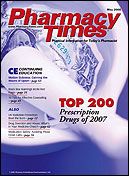Publication
Article
Pharmacy Times
UV Radiation Protection
Author(s):
As summer approaches, it is important to be aware of the harm excessive sun exposure can cause. Pharmacists are in a unique position to increase patient awareness of potential risk factors and assist them in the proper selection and application of sunscreen products.
Ms. Terrie is a clinical pharmacy writer based in Haymarket, Virginia.
UV Radiation Protection
Pharmacists are in a unique positionto increase patient awareness about thepotential risk factors for the developmentof ultraviolet (UV) radiation-relatedproblems. Two types of UV rays candamage the skin: UVA and UVB. UVA ismainly responsible for causing wrinklingand premature aging of the skin, whilesunburn is the most prevalent dermatologiccondition caused by excess exposureto UVB rays.1,2
According to statistics from the SkinCancer Foundation, an estimated 1 millioncases of skin cancer are diagnosedeach year, and 90% of those skin cancercases are the result of excessive exposureto the sun.3 An individual?s risk ofdeveloping skin cancer doubles if he orshe has had 5 or more episodes of sunburn.One case of blistering sunburn duringchildhood may double a person?s riskfor developing melanoma later in life.1,3In addition to this, excessive exposure toUV radiation can cause premature agingof the skin (also known as photoaging).Statistics show that 50% to 80% of allphotodamage to the skin happens by 20years of age.1
Risk Factors
Certain risk factors make somepatients more susceptible to developingsunburn than others. According the USNational Library of Medicine, those peopleat greatest risk of sunburn includethe following groups4:
- Children, if the skin is unprotected,since their skin is more sensitive
- Individuals with fair skin (although alltypes of skin complexions can burn)
- Individuals taking certain medications
- Individuals who use tanning beds
- Individuals exposed to the sun duringpeak hours without using UVprotection
Sunscreen Products
When applied correctly, sunscreenproducts can block most of the sun?sharmful UV rays.1 Sunscreen productsare available in various forms, such aslotions, creams, gels, and sprays, andcan come in water-resistant formulationsand various sun protection factor(SPF) ranges. Sunscreens that provideprotection against both UVA and UVBare referred to as broad-spectrum sunscreens.The American DermatologyAssociation recommends the use of abroad-spectrum sunscreen with an SPFof at least 15.1
Selecting from the wide variety ofsunscreen products available may beoverwhelming for some patients, sopharmacists should be prepared toassist in selecting a sunscreen productthat suits the patient?s individual needs.Topical sunscreen products can bedivided into 2 categories: chemical andphysical. Chemical sunscreens blockthe transmission of UV radiation to theepidermis by absorbing it, while physicalsunscreens are typically opaque andwork by reflecting and then scatteringUV rays.1 Chemical sunscreens maycontain amino benzoic acid and itsderivatives. Physical sunscreens areoften used on small areas, such as thenose or top of the ears, and contain zincoxide or titanium.1 Many products onthe market contain a combination ofingredients.
In July 2006, the FDA approved anOTC sunscreen marketed as AntheliosSX that contains a new molecular entitycalled ecamsule, which is combinedwith avobenzone and octocrylene. Thissunscreen has an SPF of 15 and is consideredas having the highest protectionagainst UVA rays.2,5
Factors to be considered whenselecting a sunscreen product mayinclude cost, skin type and complexion,reasons for using sunscreen, history ofsunburn, and medication history, becausesome medications may causephotosensitivity. It is imperative thatpatients understand how to properlyapply sunscreen products to ensuremaximum and effective protection. Sunscreensshould be applied liberally to allexposed areas at least 30 minutesbefore sun exposure. In general, an estimatedone-half teaspoonful should beapplied thoroughly to each exposedarea1 every 2 hours and after swimming,towel drying, or excessive sweating. Italso should be applied often during theday if a person works outdoors.1,6,7
Conclusion
Pharmacists are in a fundamentalposition for identifying those patients atrisk for photosensitivity reactions due tothe use of certain pharmacologic agents(ie, tetracyclines, antidepressants, antihistamines,estrogens, sulfonamides,nonsteroidal anti-inflammatory drugs,etc). During counseling, it is imperativeto remind these patients about the importanceof UV protection, not only toavoid or decrease the incidence of sunburn,but to promote the overall integrityand health of their skin.
For more information on the importanceof UV ray protection, pleasevisit the following Web sites:
American Academy of Dermatology:
For a complete list of sunscreens that have earned the Skin Cancer Foundation's seal of approval, pleasevisit: www.skincancer.org/component/option,com_virtuemart/Itemid,14.
Table
Classification of SPF
SPF
Classification
2-12
Minimal sunburn protection
12-30
Moderate sunburn protection
30 or higher
High sunburn protection
SPF= Sun protection Factor
adapted from reference 1
Table
Tips for Sun Protection
- Always apply a sunscreen with an SPF 15 or higher when going outdoors,even on a cloudy day
- Avoid the practice of tanning or using tanning beds
- Wear protective clothing, such as long-sleeved shirts and pants, widebrimmedhats, and sunglasses with UV protection
- Protect children from excess sun exposure by having them play in theshade and wear protective gear and sunscreen
- Avoid exposure to the sun during peak hours between 10 AM and 4 PM, andstay in the shade when possible
- Keep infants out of the sun and in shaded areas when possible
SPF = sun protection factor; UV = ultraviolet. Adapted from reference 8.
Table
Examples of Sunscreen Products
Aveeno Baby Continuous Protection Sunblock Lotion with SPF 55
Banana Boat Sunblock Lotion, Sport SPF 30
Banana Boat Kids Dri-Blok Sunblock Lotion, SPF 30
Bull Frog Sunblock, Quik Gel SPF 36
Coppertone ultraGUARD Lotion SPF 30
Coppertone Kids Continuous Spray Sunscreen SPF 50
Hawaiian Tropic SPF 30 Plus Sheer Touch Sunscreen
Neutrogena Ultra Sheer Dry-Touch Sunblock, SPF 70
Neutrogena Sunblock Lotion, Sensitive Skin SPF 30
Solar Sense Clear Zinc Advanced Sun Protection For Face SPF 45
References
- Caroll D, Crosby K. Prevention of Sun-induced Skin Disorders. Handbook of Nonprescription Drugs, 15th Edition. 817-837.
- Stoppler M. Making Sense of Sunscreens. MedicineNet Web site. www.medicinenet.com/script/main/art.asp?articlekey=46376.
- 2007 Skin Cancer Facts. The Skin Cancer Foundation Web site. www.skincancer.org/skincancer-facts.php.
- Risk Factors for Sunburn. MedicineNet Web site. www.medicinenet.com/script/main/art.asp?articlekey=80495.
- Anthelios Product Information Web site. www.anthelios.com.
- Sunscreen: How To Select, Apply, and Use It Correctly. Centers for Disease Control and Prevention Web site. www.cdc.gov/MMWR/preview/mmwrhtml/rr5104a3.htm.
- Sunscreens. MedlinePlus Web site. www.nlm.nih.gov/medlineplus/druginfo/medmaster/a682787.html.
- Prevention Tips. The Skin Cancer Foundation Web site. www.skincancer.org/prevention/scf-tips.html.







